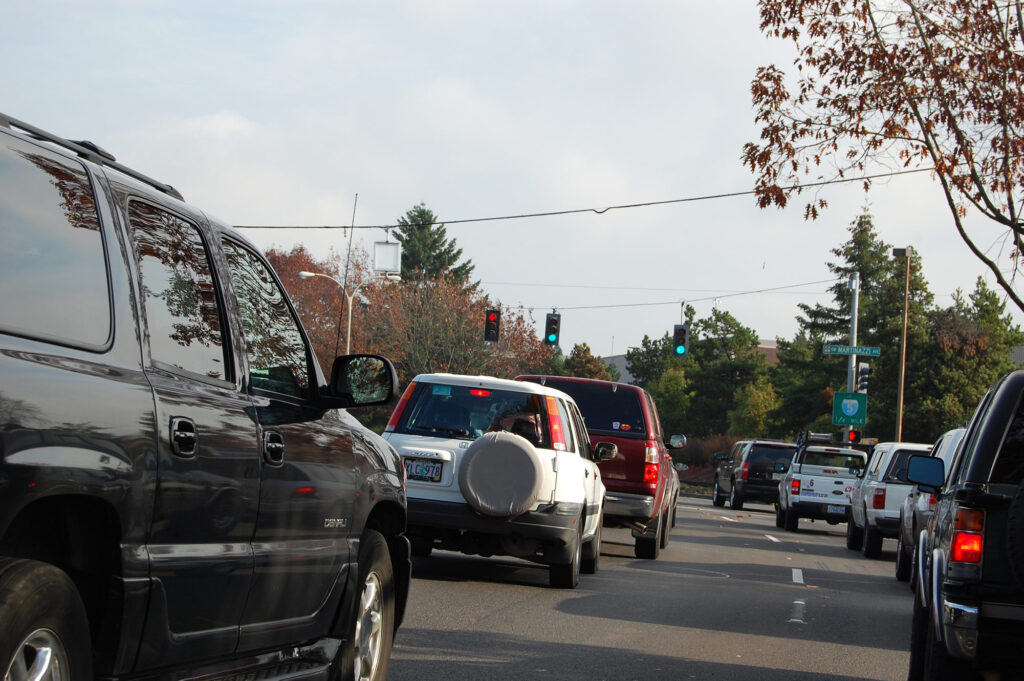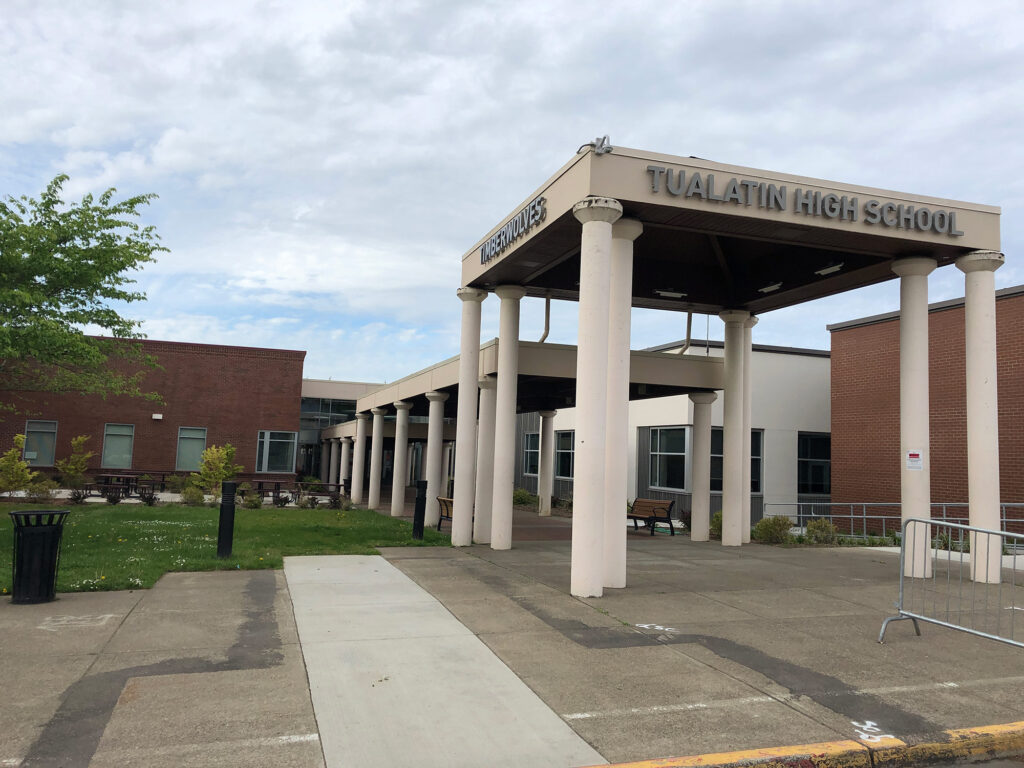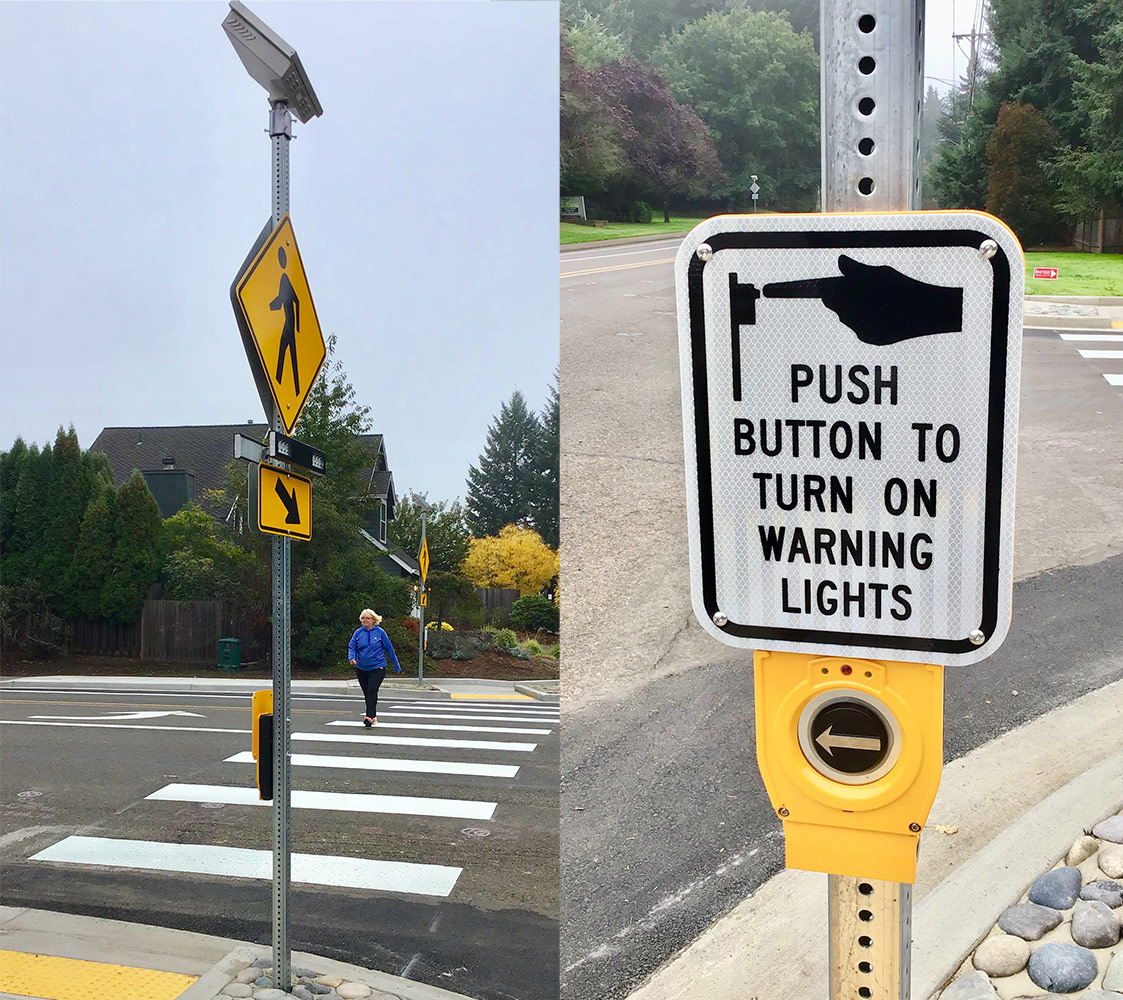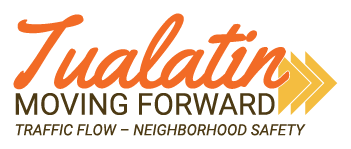Frequently Asked Questions
In May 2018, Tualatin voters approved a $20 million General Obligation bond measure – a new property tax – to pay for improvements to the City’s transportation system over the next 3 to 5 years. This program is now well underway, with the first projects completed.
Projects
Bond funds will be used citywide for projects for traffic congestion relief, neighborhood traffic safety and safe access to schools. (See “Priority Projects”)
Yes. The INRIX, Inc. Global Traffic Scorecard (February 2018) ranks Portland as the #12 most congested city of the 297 largest cities in the U.S. The WAZE Driver Satisfaction Index (December 2017) lists Portland as the #5 most congested U.S. city. Tualatin residents report that congestion on major highways encourages motorists to detour through neighborhood streets. As more people drive on city streets, they become less safe for people walking and biking. Projects that encourage drivers to obey the speed limit and yield for people crossing the street – especially near schools and parks – will make streets safer for everyone.
The planned projects will be constructed by 2023 (within 5 years of voter approval of the bond). The first five projects were completed in 2019, and another nine are under construction in 2020.
To create the initial project list for the bond measure, Community Involvement Organizations (CIOs), the Aging Task Force, local residents and businesses provided input to City staff. More than 100 projects were listed citywide. From this list, three types of projects were chosen for bond funding:
- Traffic congestion relief
- Neighborhood traffic safety
- Safe access to schools
Tualatin City Council reserved funding to be allocated citywide for installing neighborhood traffic safety projects. The potential project locations are largely identified through community input. In 2020, the annual process to find potential projects attracted 243 nominations. If you have an idea for a project you'd like to submit or a comment on any of the proposed projects please visit the ”Suggest a Project" page.
The portfolio of priority projects is expected to use all of the voter-approved bond proceeds – $20 million.
Congestion
The projects will improve traffic flow at key locations throughout the city. Changes that will allow the street system to work better include new traffic signals, reconfiguring intersections, strategically adding travel and turn lanes, and improving signage.
 Tualatin-Sherwood Road is owned by Washington County; the City is a partner on the project now underway to widen it to 5 lanes between Sherwood and Tualatin. The City’s bond-funded project will reconfigure the segment between Martinazzi and I-5 to make this section of the road more efficient and intuitive for drivers. Other non-bond-funded projects, including the recent extension of 124th Ave, will improve the roadway network and provide alternatives to traveling on Tualatin-Sherwood Road.
Tualatin-Sherwood Road is owned by Washington County; the City is a partner on the project now underway to widen it to 5 lanes between Sherwood and Tualatin. The City’s bond-funded project will reconfigure the segment between Martinazzi and I-5 to make this section of the road more efficient and intuitive for drivers. Other non-bond-funded projects, including the recent extension of 124th Ave, will improve the roadway network and provide alternatives to traveling on Tualatin-Sherwood Road.
ODOT recently completed a project to add auxiliary lanes to I-5 in Tualatin, adding some capacity to the highway at the interchanges. Washington County completed the first phases of the 124th Ave Project (Tualatin-Sherwood to Grahams Ferry), and is planning future phases of the project. TriMet improved bus service between Tualatin and Portland by expanding service on Line 96 and also planning for light rail service to Bridgeport Village. Find more information about projects underway by regional agencies at "Other Projects" or contact Tualatin Policy Analyst Garet Prior at gprior@tualatin.gov
 Upon approval of the bond, the City moved quickly to identify projects that were clearly defined and could be designed and constructed right away. These first projects were smaller and simpler than some other roadway projects. Work is now underway on bigger projects that will improve both safety and traffic flow. The first major project is Tualatin-Sherwood Rd., from Martinazzi Ave. to I-5, which involves redesigning the intersection at SW Nyberg Rd. and Fred Meyer, adding a travel lane, and changing signal timing, lane markings and signage.
Upon approval of the bond, the City moved quickly to identify projects that were clearly defined and could be designed and constructed right away. These first projects were smaller and simpler than some other roadway projects. Work is now underway on bigger projects that will improve both safety and traffic flow. The first major project is Tualatin-Sherwood Rd., from Martinazzi Ave. to I-5, which involves redesigning the intersection at SW Nyberg Rd. and Fred Meyer, adding a travel lane, and changing signal timing, lane markings and signage.
Traffic Safety
Neighborhood traffic safety projects can include new crosswalks with pedestrian-activated signals, sidewalks, curb ramp upgrades, driver feedback signs that display speed, and other solutions.
Neighborhood traffic safety projects are being planned at multiple locations, citywide, where most needed.
If it is an urgent problem – for example an injury accident – please call 911 immediately! Other traffic safety problems and possible solutions can be noted by visiting the “Suggest a Project” page.
Safe Access to Schools and Parks
School safety projects will include new mid-block crosswalks with pedestrian-activated signals, sidewalks, speed controls, and driver feedback signs that display speed.
 Tualatin High School, Tualatin Elementary, Byrom Elementary and Bridgeport Elementary School will all receive school safety projects.
Tualatin High School, Tualatin Elementary, Byrom Elementary and Bridgeport Elementary School will all receive school safety projects.
Pedestrian Activated Signals
Pedestrian-activated signals are used at intersections that don’t have a traffic signal, or at locations along a road where people walking and biking frequently need to cross. Users press a button, triggering a flashing light. This brings drivers’ attention to the person preparing to cross, and signals vehicle traffic to yield. A common type of pedestrian-activated signal is the Rectangular Rapid Flashing Beacon (RRFB), already in place at several locations in Tualatin. Learn more:
Vehicles are required to stop at all crosswalks, whether they are marked or not. Unfortunately, sometimes drivers do not stop despite the presence of a crosswalk and warning signs. Pedestrian-activated signals increase driver awareness and compliance.
Traffic signals must meet requirements of national standards, which are based on the numbers of cars and pedestrians on the main road and side streets. Many intersections do not meet the standards required to install a traffic signal. Traffic signals also require a traffic study, involving added time and money.
The specialized pedestrian-activated signals have additional benefits. Unlike a standard traffic signal, a pedestrian-activated signal prioritizes pedestrians over cars. Shortly after a pedestrian pushes the button, the yellow flashing light signals drivers to stop for pedestrians crossing the street. As soon as the pedestrians clear the roadway, the drivers may proceed even if the light is still flashing yellow. Traditional traffic signals with red/yellow/green lights do not allow pedestrians to cross as soon as they push the “walk” button. Pedestrians may need to wait several minutes before they can cross.
Pedestrian-activated signals increase driver awareness even when no one is crossing the street. In locations where pedestrian-activated signals have been installed, drivers often slow down before the crosswalk in anticipation that the flashing lights may be activated by someone wanting to cross the street. Flashing lights can be installed in advance of the crossing, in addition to the flashing lights at the crossing, to alert vehicles that someone is in the crosswalk.
 The City’s first pedestrian-activated signal is located on Leveton Drive, just west of 108th Ave near Lam Research. As a result of the Tualatin Moving Forward bond program, pedestrian-activated signals have also been installed on Sagert Street at Atfalati Park, and on Boones Ferry Road and Siletz Drive, and on Ibach Street near Ibach Park. To capture drivers’ attention, these signals utilize RRFBs – rectangular rapid-flashing beacons. By the end of 2020, six more flashing signals will be placed in various Tualatin neighborhoods.
The City’s first pedestrian-activated signal is located on Leveton Drive, just west of 108th Ave near Lam Research. As a result of the Tualatin Moving Forward bond program, pedestrian-activated signals have also been installed on Sagert Street at Atfalati Park, and on Boones Ferry Road and Siletz Drive, and on Ibach Street near Ibach Park. To capture drivers’ attention, these signals utilize RRFBs – rectangular rapid-flashing beacons. By the end of 2020, six more flashing signals will be placed in various Tualatin neighborhoods.
You can submit a request/recommendation by visiting the “Suggest a Project” page.
Driver Feedback Signs
 A driver feedback sign tells the driver of an approaching vehicle how fast they are going. The sign uses radar to determine the vehicle’s speed and displays it in real time below a posted speed limit sign. Raising awareness of actual speed improves compliance with the posted speed. Driver feedback signs are particularly useful at locations where the posted speed has recently been reduced, and are most effective on streets with one lane in each direction.
A driver feedback sign tells the driver of an approaching vehicle how fast they are going. The sign uses radar to determine the vehicle’s speed and displays it in real time below a posted speed limit sign. Raising awareness of actual speed improves compliance with the posted speed. Driver feedback signs are particularly useful at locations where the posted speed has recently been reduced, and are most effective on streets with one lane in each direction.
Driver feedback signs are for education and information and do not enforce the speed limit.
Driver feedback signs provide people with information about their actions in real time, giving them an opportunity to change their behavior and promote better behavior. The feedback sign flashing the actual speed gets the driver’s attention, alerting them they are exceeding the speed limit. The signs may also include a “slow down” message or a strobe effect. While the signs do not have cameras, the feedback often provides an impetus for drivers to self-correct. The driver feedback signs also include monitors that collect information about traffic volume, speed, time and date. The City can use this information to determine the effectiveness of the signs and consider whether enforcement measures are needed.
The City has used driver feedback signs near schools since 2003. Four more signs are now in place, along Ibach Park and Avery St between Boones Ferry and Martinazzi. Two more will be added soon along Tualatin Rd near 109th Ave and 115th Ave.
You can submit a request/recommendation by visiting the “Suggest a Project” page.
Funding
The property tax rate increased by $0.49 per $1,000 of assessed property value, or $146 per year for a Tualatin home assessed at $300,000.
Future rounds of funding are not proposed at this time. The City’s focus is successful and timely construction of the current priority projects to keep Tualatin Moving Forward.
The City considered other funding sources. Some sources are limited and/or restricted for other uses. State highway funds received by Tualatin cover only certain road projects each year, which affects Tualatin’s ability to construct other projects. The proceeds from Tualatin’s road maintenance fund are dedicated to street maintenance and are not available to support traffic congestion and safety improvement projects.
The Regional Context:
What Tualatin Residents May Notice About Traffic Congestion
Traffic
Scorecard*
Portland is the nation’s 40th largest – but #12 most congested metro area (of 297 metro cities)
#13 in North America (319 cities) – more congested than any city in Mexico and every Canadian city except Montreal.
#40 most congested in world (1,360 cities)
Portland area congestion is worst at peak commute hours, but now present at all times of day/week
Most Congested U.S. Cities**
- 1 Honolulu
- 2 Jacksonville
- 3 San Diego
- 4 Los Angeles
- 5 Portland
* Source: INRIX Global Traffic Scorecard, February 2018
** Source: WAZE Driver Satisfaction Index, December 2017

